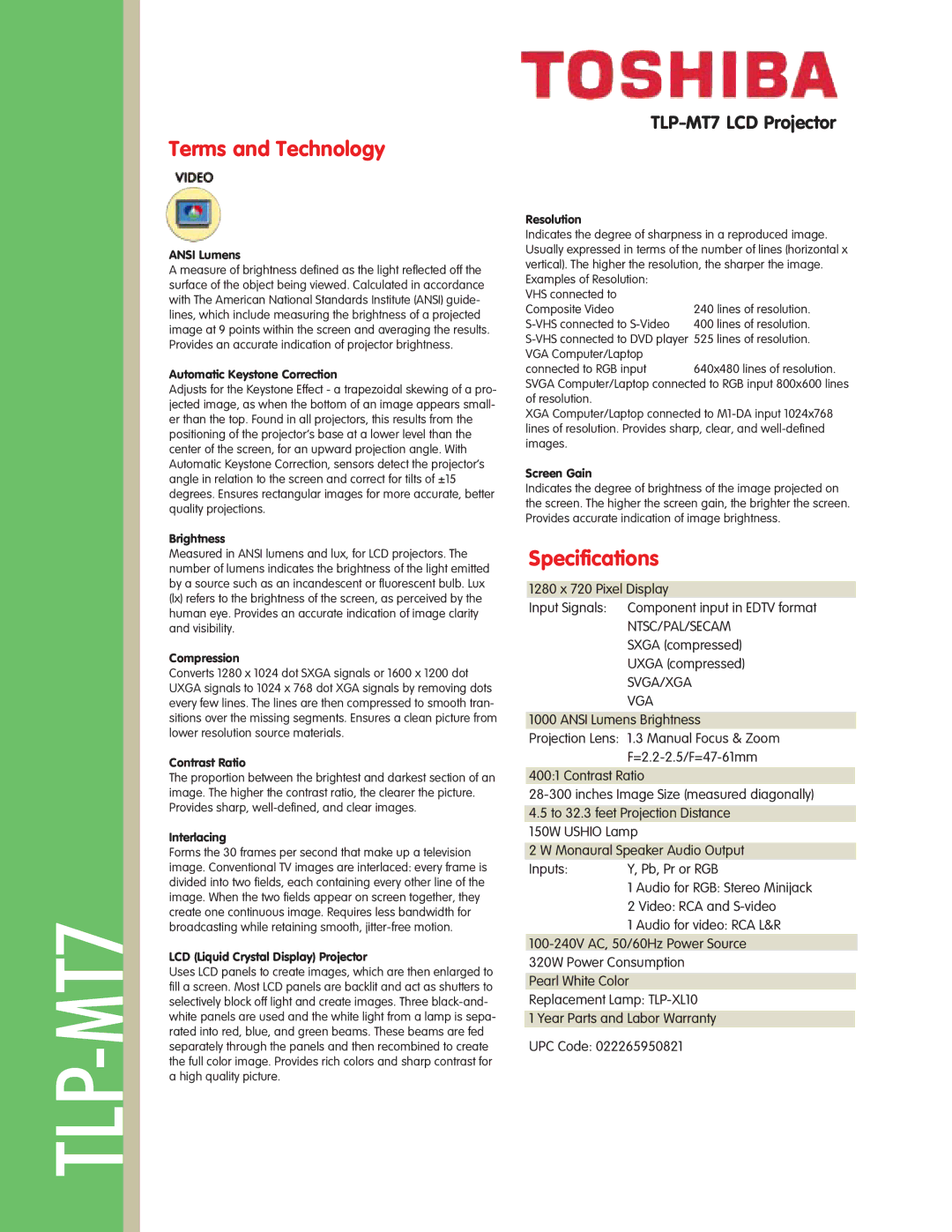
Terms and Technology
TLP-MT7
ANSI Lumens
A measure of brightness defined as the light reflected off the surface of the object being viewed. Calculated in accordance with The American National Standards Institute (ANSI) guide- lines, which include measuring the brightness of a projected image at 9 points within the screen and averaging the results. Provides an accurate indication of projector brightness.
Automatic Keystone Correction
Adjusts for the Keystone Effect - a trapezoidal skewing of a pro- jected image, as when the bottom of an image appears small- er than the top. Found in all projectors, this results from the positioning of the projector's base at a lower level than the center of the screen, for an upward projection angle. With Automatic Keystone Correction, sensors detect the projector's angle in relation to the screen and correct for tilts of ±15 degrees. Ensures rectangular images for more accurate, better quality projections.
Brightness
Measured in ANSI lumens and lux, for LCD projectors. The number of lumens indicates the brightness of the light emitted by a source such as an incandescent or fluorescent bulb. Lux (lx) refers to the brightness of the screen, as perceived by the human eye. Provides an accurate indication of image clarity and visibility.
Compression
Converts 1280 x 1024 dot SXGA signals or 1600 x 1200 dot UXGA signals to 1024 x 768 dot XGA signals by removing dots every few lines. The lines are then compressed to smooth tran- sitions over the missing segments. Ensures a clean picture from lower resolution source materials.
Contrast Ratio
The proportion between the brightest and darkest section of an image. The higher the contrast ratio, the clearer the picture. Provides sharp,
Interlacing
Forms the 30 frames per second that make up a television image. Conventional TV images are interlaced: every frame is divided into two fields, each containing every other line of the image. When the two fields appear on screen together, they create one continuous image. Requires less bandwidth for broadcasting while retaining smooth,
LCD (Liquid Crystal Display) Projector
Uses LCD panels to create images, which are then enlarged to fill a screen. Most LCD panels are backlit and act as shutters to selectively block off light and create images. Three
Resolution
Indicates the degree of sharpness in a reproduced image. Usually expressed in terms of the number of lines (horizontal x vertical). The higher the resolution, the sharper the image.
Examples of Resolution: |
|
VHS connected to |
|
Composite Video | 240 lines of resolution. |
400 lines of resolution. | |
525 lines of resolution. | |
VGA Computer/Laptop |
|
connected to RGB input | 640x480 lines of resolution. |
SVGA Computer/Laptop connected to RGB input 800x600 lines of resolution.
XGA Computer/Laptop connected to
Screen Gain
Indicates the degree of brightness of the image projected on the screen. The higher the screen gain, the brighter the screen. Provides accurate indication of image brightness.
Specifications
1280 x 720 Pixel Display
Input Signals: Component input in EDTV format
NTSC/PAL/SECAM
SXGA (compressed)
UXGA (compressed)
SVGA/XGA VGA
1000 ANSI Lumens Brightness
Projection Lens: 1.3 Manual Focus & Zoom
400:1 Contrast Ratio
4.5to 32.3 feet Projection Distance 150W USHIO Lamp
2 W Monaural Speaker Audio Output
Inputs: | Y, Pb, Pr or RGB | |
| 1 | Audio for RGB: Stereo Minijack |
| 2 Video: RCA and | |
| 1 | Audio for video: RCA L&R |
320W Power Consumption
Pearl White Color
Replacement Lamp:
1 Year Parts and Labor Warranty
UPC Code: 022265950821
